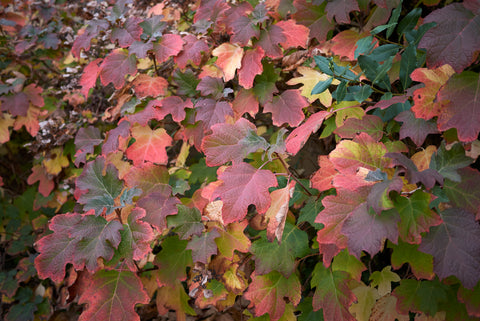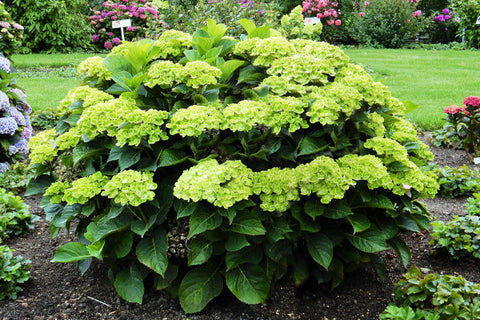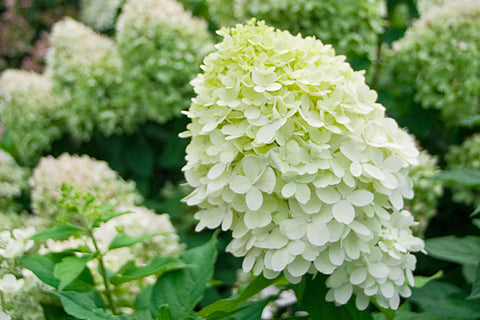Types of Hydrangeas: Which Hydrangea Should You Plant?

Last updated: May 12 2022

Ah, the famous hydrangea. Have you ever known a flowering shrub as vibrant, varied, or vast? This plant thrives in most parts of the country, and you’ve no doubt seen a variety or two around. And they’re popular for good reason—with over 75 species and a multitude of colors and styles, the hydrangea is one of the most diverse plants we carry!
However, because of its impressive range of varieties, it’s normal to wonder which hydrangea type you should plant (or even what kind of hydrangea is already in your yard!).
We’re here to answer all your questions about the types of hydrangeas, from the most obscure to the most popular.
Searching for the right hydrangea based on its color, features, or shape? Click here to jump to Choosing Your Hydrangea.
What to Know About Hydrangeas
There’s much to know about hydrangeas: their growth rate, how to plant them, and their sunlight, soil, water, and pruning needs. What makes them thrive? How can you make your hydrangea bloom more proficiently? Let’s explore some fast facts about hydrangeas, so you can determine the best care for yours!
Basic Types of Hydrangeas
There are several main types of hydrangeas. These groups are different from the many varieties (we’ll get into those later).

Oakleaf Hydrangeas
This hydrangea variety is known for its oak-like foliage (see picture above). Not only do its leaves look like the deciduous tree, but they also glow with the autumn shades in the fall. Oakleaf hydrangeas thrive best in warmer zones, especially Zones 5 and higher, because they can withstand the summer heat.

Bigleaf Hydrangeas
The bigleaf hydrangeas are the most common among gardeners. As their name implies, they are characterized by their huge leaves (see above). This hydrangea variety is most often found growing in Zones 5 through 9.

Panicle Hydrangeas
Probably one of the lowest maintenance of all hydrangea types, the panicle hydrangeas are hardy to Zone 3. You can spot a panicle hydrangea by its cone-shaped blossom (shown above). A variety that’s both woody and strong, these easy growers can be pruned to look like trees. They can also reach up to 15 feet tall!

Smooth Hydrangeas
Smooth hydrangeas are called “smooth” for their blossoms’ smooth, round shape. Also known as “snowballs” for their white-bloomed varieties, these plants are an excellent choice for cold climates. And they can tolerate full sun, unlike other hydrangea types, if they receive plenty of water.

Mophead Hydrangeas
Mopheads are actually a subtype of bigleaf hydrangeas. Their flowers can bloom in purple, pink, and blue, depending on soil pH. Also very low maintenance, the mophead hydrangea variety requires absolutely no pruning. Their blooms are huge—as big as, well, the head of your mop.
More Hydrangea Categories
Other, lesser known hydrangea types include climbing hydrangeas and lacecap hydrangeas.
General Care for Hydrangeas
Different hydrangea varieties may require specific needs, so it’s always good practice to double-check any planting or care instructions that come with your plant. However, below we’ve included some general guidelines for most hydrangea plants. (You can also check out our blog post on Hydrangea Care to see more in-depth advice.)
- Plant your hydrangeas in areas with partial sunlight, prioritizing morning sun (afternoon shade can be too powerful).
- Hydrangeas typically prefer fertile, well-draining soil with plenty of moisture.
- Water your hydrangea well about once per week throughout the growing season (and add more water during droughts or prolonged dry periods).
- Hydrangeas don’t always need to be fertilized. Just check the soil and variety type to find out whether fertilization is necessary.
- Pruning will depend entirely on which type of hydrangea you have. The bigleaf types will require pruning in summer after flowering. Others will need to be pruned in late winter before spring growth. Some won’t require pruning at all
Hydrangea Sizes
How big can a hydrangea get? Size can vary among types, but it’s always recommended you space hydrangeas at least a few feet to allow for growth.
Some hydrangea varieties can grow up to fifteen feet in height! Others stay fairly compact, so ensure that you research your specific variety before committing to a certain location in your yard, potted container, or garden.
Hydrangea Blooming
As with any flowering plant, you want to enjoy its blossoms’ beauty and color for as long as possible! So, which hydrangeas bloom the longest? Many varieties flower in early spring and can continue blooming into fall or early winter.
While it does depend on the level of care as well, the longest-lasting hydrangeas tend to be reblooming hydrangeas (see our suggestions below). These flower on both new and old growth, meaning you get vibrant colors for a majority of the year. A popular group of reblooming hydrangeas are the Endless Summer hydrangeas—aptly named for their long blooming season!
What Kind Do I Have?
Identifying your hydrangea can be quite simple. You can generally decipher the type of hydrangea by:
- Leaf shape
- Whether it’s a climbing plant
- Number of leaves
- Flower colors
- Petiole length (or the stalk that joins a leaf to a stem)
Take note of each of these features, and then use them to do a quick online search. This information will almost always lead to plant identification. Once you know the variety name, you can begin caring for it appropriately.
Different Kinds of Hydrangeas
What are the different kinds of hydrangea plants? We’ll dive into the multitude of varieties soon, but first let’s take a look at the most common and popular types!
Most Common Type
Bigleaf hydrangeas are the most common type of hydrangea in the United States. They include the mophead, lacecap, and mountain hydrangeas.
Most Popular
The most popular hydrangeas are also the most common—the bigleaf hydrangeas! As far as color is concerned, most people lean toward bigleaf hydrangeas that produce pink and blue flowers, depending on soil acidity.
Easiest Maintenance
The “beginner” hydrangea, or one that requires the lowest maintenance, are the oakleaf varieties. Not only do they tolerate colder weather and can withstand drought, but they are also more resistant to diseases and pests. These hydrangeas can even grow in sandy soil, and they love the sun!
The Hydrangea Plant: Tree or Bush?
Is there such a thing as a hydrangea tree? While all hydrangeas are technically shrubs, some varieties can be carefully pruned to look similar to trees, like those in our Hydrangea Trees collection.
Choosing the Right Hydrangea
When choosing your hydrangea, you may be overwhelmed at how many different varieties there are. Thankfully, this nifty guide will help break down each one for you so that the choice is much easier!
Reblooming & Long-Blooming Hydrangeas
The most well-known long-bloomers are the Endless Summer® hydrangeas. But there are several different varieties that are considered “reblooming” or have a long-lasting blooming season. We’ve also separated them by color below:
Red and Pink (Purple and Blue) Blooms
Hydrangeas are fascinating because many can change color based on soil acidity. We indicate with an asterisk* the plants that more easily create blue or purple blooms with certain soil pH levels.
- Red Sensation Hydrangea
- Love Hydrangea
- Invincibelle® Ruby Hydrangea Shrub
- Endless Summer® Hydrangea Shrub*
- Endless Summer® Pop Star™ Hydrangea*
- Endless Summer® Summer Crush® Hydrangea*
- Endless Summer® BloomStruck® Hydrangea Shrub*
- Elizabeth Ashley Hydrangea Shrub*
- Blue Enchantress® Hydrangea*
Multi-Color Blooms
White Blooms
- Onyx™ Zebra Hydrangea
- Endless Summer® Blushing Bride Bigleaf Hydrangea Shrub
- Wedding Gown Hydrangea Shrub
Panicle Hydrangeas (Cone-Shaped Blooms, Low Maintenance)
Panicle hydrangeas have distinct, cone-shaped flower heads. They’re also the type of hydrangea that can be carefully pruned into tree form. Plus, most panicles are cold-hardy, adaptable, and relatively low maintenance.
Hydrangea Trees
- Limelight Hydrangea Tree
- Vanilla Strawberry™ Hydrangea Tree
- Fire Light® Hydrangea Tree
- Little Lime® Hydrangea Tree
Multi-Color Blooms
- Early Evolution Hydrangea
- Little Lime® Hydrangea Shrub
- Limelight Hydrangea Shrub
- Fire Light® Hydrangea Shrub
White Blooms
Unique Hydrangea Varieties
If you’re looking for a hydrangea that’s different from all the rest, we’ve curated several lists based on uncommon growing colors, foliage, or bloom shape.
Hydrangea Vines That Climb!
Hydrangeas With Color-Changing Foliage (Oakleaf)
- Alice Oakleaf Hydrangea
- Munchkin Hydrangea Shrub
- Ruby Slippers Hydrangea Shrub
- Snowcicle Hydrangea Shrub
- Oakleaf Hydrangea Shrub
Compact, Container-Friendly Hydrangeas for Small Spaces
Hydrangeas With Delicately-Petaled Blossoms (Lacecap)
- Climbing Hydrangea
- Bluebird Hydrangea Shrub
- Tuff Stuff Ah-Ha® Hydrangea Shrub
- Wedding Gown Hydrangea Shrub
- Red Rhapsody® False Hydrangea Vine
A Wide Variety of Hydrangeas
With so many different hydrangea options, how could one possibly choose? These plants are choice perennials among gardeners for various reasons—each shrub has something to offer, whether it be low maintenance color; big, showy blossoms, a long blooming season; or dense, compact foliage.
To find inspiration for your home garden space, shop our full Hydrangea Collection now! And check out our Complete Hydrangea Guide to choose the right type for you.
Written by
Elizabeth Durham
Though cursed at birth with a black thumb, Elizabeth always dreamed of being a plant person. Turns out she just needed a little guidance—now she’s the proud mama of nearly a dozen house plants! After joining FastGrowingTrees.com as a Content Strategist, she’s expanded her knowledge tenfold and learned how to keep her plants alive…most of the time.
As a newbie in the plant world, Elizabeth understands the struggles of beginner gardeners. And as an experienced writer, she loves creating content that makes difficult concepts easy to understand. In her free time, she enjoys immersing herself in nature through daily lunchtime walks, weekend hikes, and visits to the park with her dog Fred.
Featured Product

Thuja Green Giant Arborvitae
3105 reviewsStarting at $19.95

























































































































































































































































